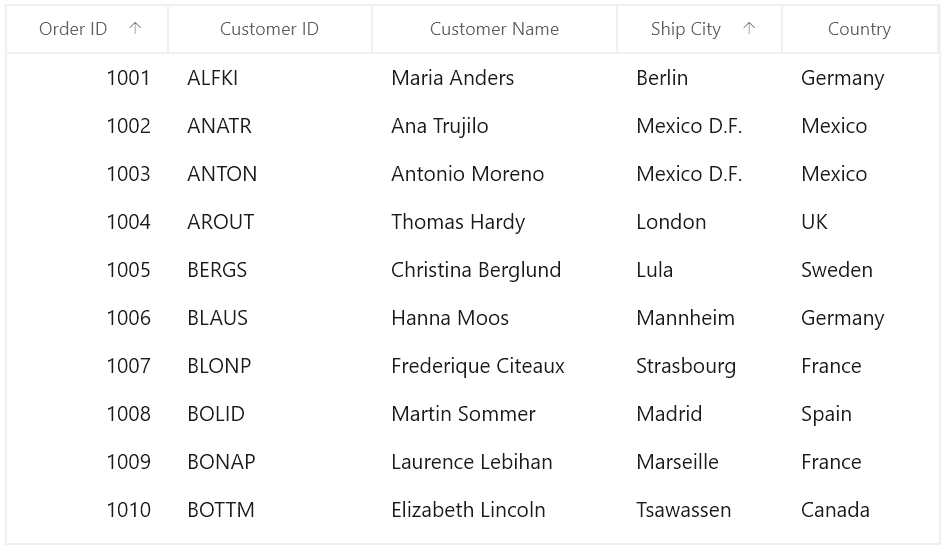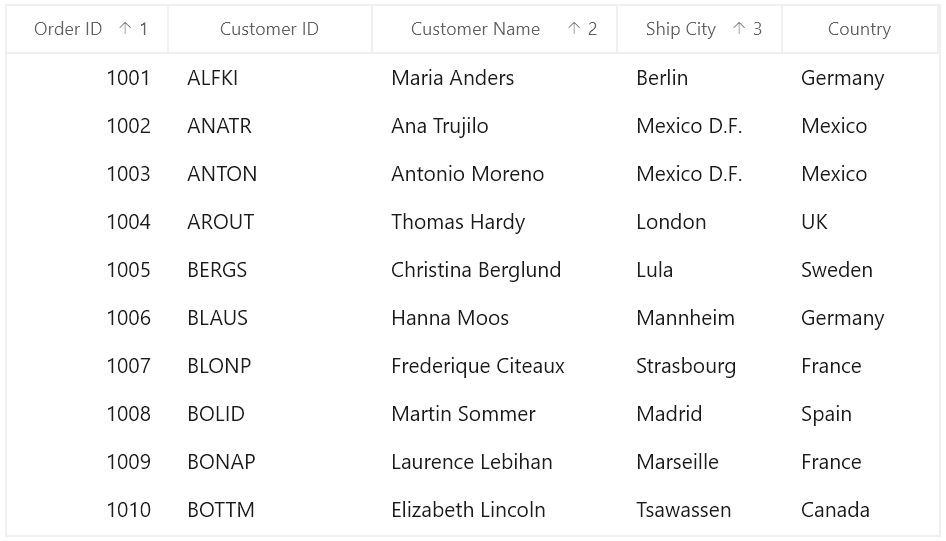Sorting in WinUI DataGrid
27 Feb 202513 minutes to read
DataGrid allows you to sort the data against one or more columns either in ascending or descending order. When sorting is applied, the rows are rearranged based on sort criteria. You can allow users to sort the data by touching or clicking the column header using SfDataGrid.AllowSorting property to true.
<dataGrid:SfDataGrid x:Name="sfDataGrid"
AllowSorting="True"
ItemsSource="{Binding Orders}"/>sfDataGrid.AllowSorting = true;In another way, you can enable or disable the sorting for particular column by setting the GridColumn.AllowSorting property.
<dataGrid:SfDataGrid x:Name="sfDataGrid"
AllowSorting="False"
AutoGenerateColumns="False"
ItemsSource="{Binding Orders}">
<dataGrid:SfDataGrid.Columns>
<dataGrid:GridTextColumn AllowSorting="True" MappingName="OrderID" />
<dataGrid:GridTextColumn AllowSorting="False" MappingName="CustomerID" />
<dataGrid:GridTextColumn AllowSorting="False" MappingName="CustomerName" />
<dataGrid:GridTextColumn AllowSorting="True" MappingName="ShipCity" />
<dataGrid:GridTextColumn AllowSorting="True" MappingName="Country" />
</dataGrid:SfDataGrid.Columns>
</dataGrid:SfDataGrid>this.sfDataGrid.Columns["OrderID"].AllowSorting = true;
this.sfDataGrid.Columns["CustomerID"].AllowSorting = false;NOTE
The GridColumn.AllowSorting takes higher priority than SfDataGrid.AllowSorting property.
End users can sort the column by clicking column header cell. Once the columns get sorted, the sort indicator will be displayed on the right side of the column header.

Sort column in double click
By default, column gets sorted when column header clicked. You can change this behavior to sort the column in double click action by setting SfDataGrid.SortClickAction property to DoubleClick.
<dataGrid:SfDataGrid x:Name="sfDataGrid"
AllowSorting="True"
AutoGenerateColumns="True"
ItemsSource="{Binding Orders}"
SortClickAction="DoubleClick" />this.sfDataGrid.SortClickAction = SortClickAction.DoubleClick;Sorting order
By default, the data is sorted in ascending or descending order when clicking column header. You can rearrange the data to its initial order from descending, when clicking column header by setting SfDataGrid.AllowTriStateSorting property.
Following are the sequence of sorting orders when clicking column header,
-
Sorts the data in ascending order
-
Sorts the data in descending order
-
Clears the sorting and records displayed in its initial order
Multi column sorting
SfDataGrid control allows you sort more than one column, where sorting is applied one column against other columns.
To apply sorting on multiple columns, user have to click the column header by pressing the Ctrl key.
In the below screen shot, the OrderID column sorted. Then the CustomerName column is sorted against the OrderID data by clicking column header by pressing Ctrl key. The sorting state of OrderID column is preserved and CustomerName column sorted against OrderID column.

Display sort order
It is also possible to display sorted order of columns in header by setting SfDataGrid.ShowSortNumbers property to true.
<dataGrid:SfDataGrid x:Name="sfDataGrid"
AllowSorting="True"
ShowSortNumbers="True"
ItemsSource="{Binding Orders}" />this.sfDataGrid.ShowSortNumbers = true;
Programmatic sorting
You can sort the data programmatically by adding or removing the SortColumnDescription in SfDataGrid.SortColumnDescriptions property.
NOTE
SfDataGrid.SortColumnsChanging and SfDataGrid.SortColumnsChanged events are not raised when the data sorted programmatically through
SfDataGrid.SortColumnDescriptions.
Adding sort columns
xmlns:grids="using:Syncfusion.UI.Xaml.Grids"
<dataGrid:SfDataGrid x:Name="sfDataGrid"
AutoGenerateColumns="True"
ItemsSource="{Binding Orders}">
<dataGrid:SfDataGrid.SortColumnDescriptions>
<grids:SortColumnDescription ColumnName="OrderID" SortDirection="Ascending" />
<grids:SortColumnDescription ColumnName="CustomerName" SortDirection="Descending" />
</dataGrid:SfDataGrid.SortColumnDescriptions>
</dataGrid:SfDataGrid>this.sfDataGrid.SortColumnDescriptions.Add(new SortColumnDescription() { ColumnName = "OrderID", SortDirection = SortDirection.Ascending });
this.sfDataGrid.SortColumnDescriptions.Add(new SortColumnDescription() { ColumnName = "CustomerName", SortDirection = SortDirection.Descending });Removing sort columns
You can unsort the data by removing the corresponding SortColumnDescription from the SfDataGrid.SortColumnDescriptions property.
var sortColumnDescription = this.sfDataGrid.SortColumnDescriptions.FirstOrDefault(col => col.ColumnName == "OrderID");
if (sortColumnDescription != null)
{
this.sfDataGrid.SortColumnDescriptions.Remove(sortColumnDescription);
}Clear sorting
You can clear sorting, by clearing the SfDataGrid.SortColumnDescriptions.
this.sfDataGrid.SortColumnDescriptions.Clear();Custom sorting
SfDataGrid allows you to sort the columns based on the custom logic. The custom sorting can be applied by adding the SortComparer instance to SfDataGrid.SortComparers.
The SortComparer have the following properties,
PropertyName - Gets or sets the name of the column to apply custom sorting.
Comparer - Gets or sets the custom comparer in which you can code to compare the data using custom logic.
Follow the below steps to add custom comparer to sort using custom logic,
Define custom comparer with custom sort logic
In the below code snippet, CustomerName property is compared based on its string length, instead of default string comparison.
public class CustomComparer : IComparer<object>
{
public int Compare(object x, object y)
{
int nameX;
int nameY;
//While data object passed to comparer
if (x.GetType() == typeof(OrderInfo))
{
nameX = ((OrderInfo)x).CustomerName.Length;
nameY = ((OrderInfo)y).CustomerName.Length;
}
//While sorting groups
else if (x.GetType() == typeof(Group))
{
//Calculating the group key length
nameX = ((Group)x).Key.ToString().Length;
nameY = ((Group)y).Key.ToString().Length;
}
else
{
nameX = x.ToString().Length;
nameY = y.ToString().Length;
}
int cmp = 0;
cmp = nameX.CompareTo(nameY);
return cmp;
}
}Adding custom comparer to SfDataGrid
Custom comparer can be added to SfDataGrid.SortComparers property. SortComparers maintains custom comparers and the custom comparer gets called when corresponding column gets sorted by clicking column header or programmatically.
xmlns:data="using:Syncfusion.UI.Xaml.Data"
xmlns:grids="using:Syncfusion.UI.Xaml.Grids"
<Page.Resources>
<local:CustomComparer x:Key="comparer" />
</Page.Resources>
<dataGrid:SfDataGrid x:Name="sfDataGrid" ItemsSource="{Binding Orders}">
<dataGrid:SfDataGrid.SortComparers>
<data:SortComparer Comparer="{StaticResource comparer}" PropertyName="CustomerName" />
</dataGrid:SfDataGrid.SortComparers>
<dataGrid:SfDataGrid.SortColumnDescriptions>
<grids:SortColumnDescription ColumnName="CustomerName" SortDirection="Ascending" />
</dataGrid:SfDataGrid.SortColumnDescriptions>
</dataGrid:SfDataGrid>this.sfDataGrid.SortComparers.Add(new SortComparer() { Comparer = new CustomComparer(), PropertyName = "CustomerName" });Sorting CustomerName column sorts the data using custom comparer available in SfDataGrid.SortComparers.

Sorting the underlying collection
SfDataGrid sorts the records in UI and maintains in its internal CollectionView and it will not change the order of data in underlying collection. You can get sorted data from SfDataGrid.View.Records when groups are not in place and SfDataGrid.View.TopLevelGroup.DisplayElements when grouping in place.
If you want to sort the underlying collection when sorting takes place, then this can be achieved by handling SfDataGrid.SortColumnsChanged event.
this.sfDataGrid.SortColumnsChanged += SfDataGrid_SortColumnsChanged;
private void SfDataGrid_SortColumnsChanged(object sender, GridSortColumnsChangedEventArgs e)
{
var viewModel = this.DataContext as ViewModel;
IEnumerable<OrderInfo> OrderedSource = viewModel.Orders;
foreach (var sortColumn in this.sfDataGrid.View.SortDescriptions)
{
var columnName = sortColumn.PropertyName;
if (sortColumn.Direction == SortDirection.Ascending)
OrderedSource = OrderedSource.OrderBy(source => GetOrderSource(source, columnName));
else
OrderedSource = OrderedSource.OrderByDescending(source => GetOrderSource(source, columnName));
}
}
using System.Reflection;
private object GetOrderSource(OrderInfo source, string name)
{
var propInfo = source.GetType().GetRuntimeProperty(name);
if (propInfo != null)
// Get the current sort column value
return propInfo.GetValue(source);
return null;
}Handling events
SortColumnsChanging event
SfDataGrid.SortColumnsChanging event occurs while sorting the columns by clicking column header. GridSortColumnsChangingEventArgs has following members which provides information for SortColumnsChanging event.
Action – Gets the action triggered this event.
Cancel – Setting value to true, cancels the triggered action.
AddedItems - Gets the list of new SortColumnDescription’s that are added.
RemovedItems - Gets the list of SortColumnDescription’s that are removed.
CancelScroll - Gets or sets a value that indicates, whether scroll and bring SelectedItem in view after sorting takes place.
You can prevent sorting for the particular column through GridSortColumnsChangingEventArgs.Cancel property of SortColumnsChanging event.
this.sfDataGrid.SortColumnsChanging += SfDataGrid_SortColumnsChanging;
private void SfDataGrid_SortColumnsChanging(object sender, GridSortColumnsChangingEventArgs e)
{
if (e.AddedItems[0].ColumnName == "OrderID")
{
e.Cancel = true;
}
}SortColumnsChanged event
SfDataGrid.SortColumnsChanged event occurs when the sorting is applied to the column. GridSortColumnsChangedEventArgs provides information for SortColumnsChanged event.